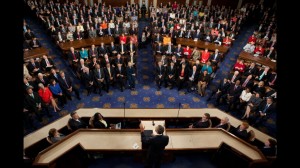President Obama sent the text of the American Jobs Act to Congress on Monday. The bill, which is meant to reduce unemployment and generate long-term economic growth, has a price tag of $447 billion. It consists of $253 billion in tax cuts for both employees and businesses with an additional $194 billion in spending measures on areas such as infrastructure, and education.

Make no mistake about it, the American Jobs Act is another stimulus bill — the kind that makes Tea Party-ers parade around the National Mall holding pictures of Nancy Pelosi superimposed over Joseph Stalin while wearing funny hats. However, stimulus need not be a dirty word. Mainstream economists generally agree that short term stimulus spending coupled with long-term structural spending cuts will reduce the deficit and bring the United States back to acceptable levels of growth and unemployment.
Even stimulus skeptics such as right-leaning New York Times Columnist David Brooks argue that stimulus measures by Congress are necessary given the threat of a double-dip recession, consistently slow levels of growth, and high unemployment.
It is a bit of a stretch to argue that this piece of legislation will bring the United States to pre-9/11 growth rates and unemployment levels before the 2012 election. It does have weaknesses. For example, there are employee payroll tax cuts which result in approximately $1,500 saved in taxes for the average American family. The idea is that families can use this money to pay down their household debt. But for a family who defaulted on their mortgage, how significant is $1,500? I also have a hard time buying the idea that tax cuts for businesses will get them to start hiring more workers — we have 30 years of evidence to show that trickle down economics has minimal effects on employment levels.
Additionally, some of the incentives to hire unemployed workers are populist nonsense. If employers are hiring, they should base it on which workers are most qualified, not which provide them with the best tax break. I can’t see this sort of policy doing anything other then creating talking points for members of Congress to share with their constituents.
That said, President Obama successfully utilized nearly every weapon in the stimulus arsenal in creating the American Jobs Act to appeal to a partisan Congress. This bill will provide aid to areas that are lacking such as infrastructure and education, and provide some relief to middle class Americans, while providing incentives for business to invest and hire new workers. Some of the incentives may be strong enough to encourage businesses to hire new workers.
Context is crucial here. As we saw during the debt ceiling debacle with the “Grand Bargain,” big ideas are useless if they can’t get through Congress. Given the challenging political and economic climate the President faces, this may be the best bill that could get passed by Congress. If the Debt ‘Super’ Committee can create some meaningful legislation — deep cuts in redundant programs, a tax code overhaul and entitlement reform– together with the American Jobs Act, Congress will be able to salvage our economic situation.
Make no mistake about it, this is a good bill that puts the United States on the right track to economic growth and deserves the support of Congress.
Here are a few key parts of the bill:
Tax Policy
- Tax Cuts for American Families: Employee Payroll Tax Cuts ($175 billion) — A key part of the legislation that decreases the amount employees pay in taxes on their earnings from 6.2% to 3.1% for the year 2012.
- Small Business Tax Cuts: Employer Payroll Tax Cuts and Payroll Tax Holiday ($65 billion) — Decreases the amount that businesses pay on wages to employees to 3.1% for the first $5 million in their payroll, affecting 98% of businesses. The bill will also completely eliminate payroll taxes for companies that hire new workers or pay their workers more money. These provisions have been well supported by Republicans in Congress.
- Hiring and Investment Incentives ($13 billion) — The bill includes a number of provisions that give companies tax breaks for hiring workers, including those who have been unemployed for 6 months or longer. It also includes tax breaks for businesses that make new investments.
Spending
- Infrastructure ($ 50 billion) — Immediately invests in highway, rail, and aviation projects.
- Infrastructure Bank ($10 billion) — A favorite program of Democrats, the bill creates a bank that provides low-interest loans to private sector projects.
-
Aid to Local and State Governments ($80 billion) — Provides funding to state and local governments for a number of programs including rehiring or not firing teachers and first responders ($35 billion), modernizing public schools and community colleges ($30 million) and fixing up vacant homes ($15 billion) among others.
- Unemployment Extension and Reform ($49 billion) — Extends unemployment benefits, preventing 5 million Americans from losing their government funding, while developing job-training programs for the unemployed that are modeled off of current state programs.


One Comment on “A Guide to the American Jobs Act”